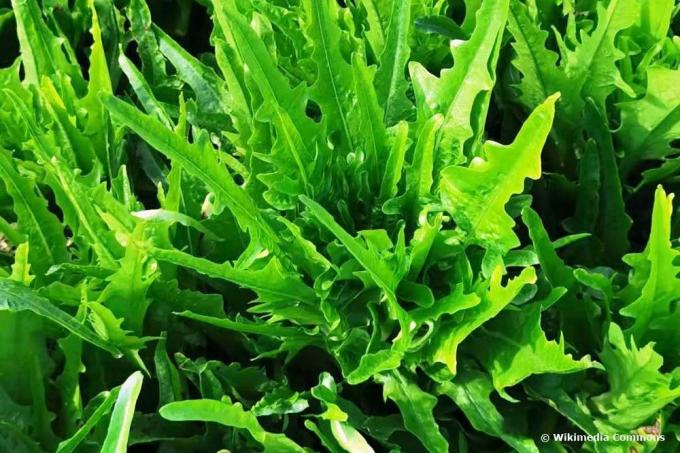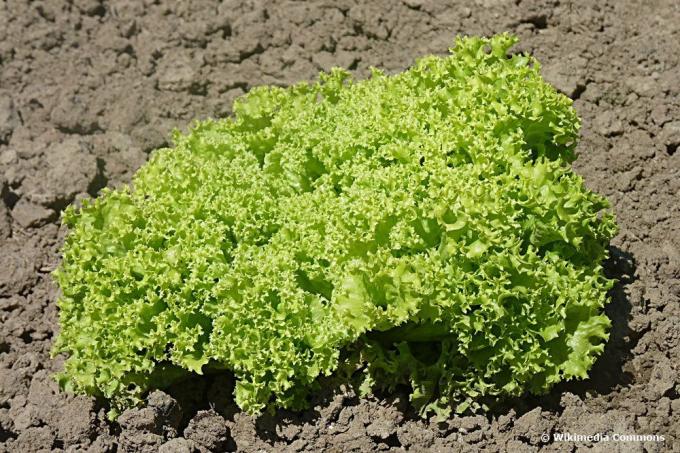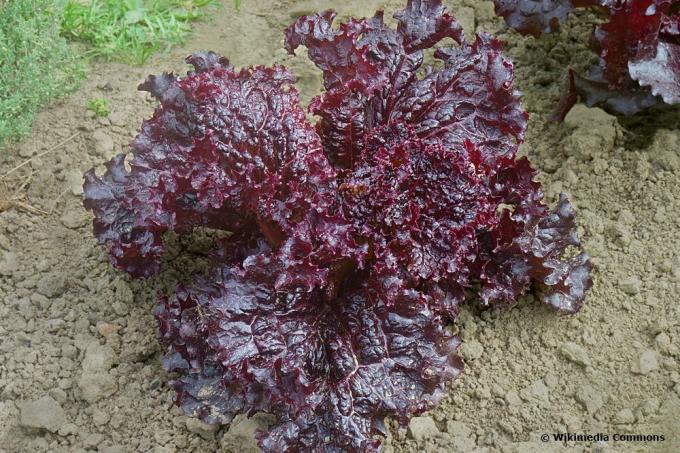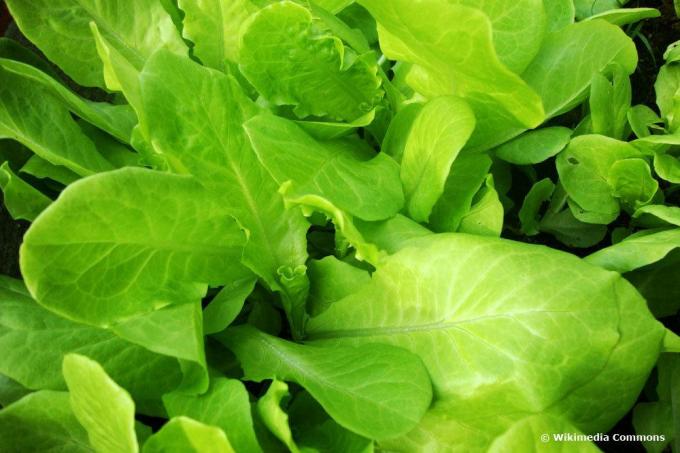
table of contents
- Varieties from A - C
- Varieties from D - K
- Varieties from L - Q
- Varieties from R - Z
- frequently asked Questions
Just as versatile as the culinary usability are the varieties of cultivable pick salads for the home garden. In this guide, the gardener will find a clear selection including information on location conditions and planting time.
In a nutshell
- continuous harvest possible
- differently pronounced taste from mild to nutty
- Move forward from March
- Planting time from April
- humic soil
- Seed depth 0.5 cm
Varieties from A - C
Australian yellow
- Leaf color: green-yellow
- Leaf shape: curly

The Australian yellow owes its name to its strikingly bright leaves. In a warm location, the lettuce forms heads up to 40 cm in size. The soil should be humus and loose. A bed in a sunny location is well suited. The Australian yellow also tolerates penumbra. The gardener can also cultivate it in the balcony box. However, this is only possible with a single lettuce, as the gardener has to separate this variety first to 5 cm, later to 10-20 cm, as soon as the leaves touch. Here the lettuce enjoys the company of:
- Kohlrabi
- radish
- fennel
- peas
The good neighborhood rewards the vegetable plant with high yields. The germination time is just 6 to 15 days. Another great thing about the Australian Yellow is that it shoots late.
Catalogna
- Leaf color: light green
- Leaf shape: lobed, serrated

With its long, serrated leaves, the Catalogna is somewhat reminiscent of an oversized dandelion. In the greenhouse, cultivation is possible all year round. Cultivation is definitely worth it from a culinary point of view. The crunchy leaves taste spicy, slightly bitter and can even be boiled like spinach. A great advantage of this strain is that it is bulletproof.
Varieties from D - K
Oak leaf lettuce
- Leaf color: green or red
- Leaf shape: serrated

Of the Oak leaf lettuce is suitable for cultivation outdoors or in pots. The main thing is that it is sunny to partially shaded and thrives in a loose, humus-rich, well-drained and, above all, nutrient-rich soil. It is a young cultivated form from which numerous different varieties have emerged:
- Bijella: variegated variety, mostly brownish with a green heart
- Bolchoi: compact growth, curly leaves
- Navara: green or red leaves
- Radichetta: serrated, pointed leaves in green
- Red Salad Bowl: big, red heads
- Salad Bowl: also big heads in green
- Till: pointed, green leaves with a yellow heart
The oak leaf salad is known for its hazelnut-like, delicate taste. Restaurateurs are happy to use it to decorate the buffet. The heads of lettuce in light green or with a red shimmer also look attractive in the garden. The combination with:
- fennel
- horseradish
- rhubarb
- radish
- dill
- tomatoes
- chervil
- or other pick salads
but rather serves the practical purpose of being a good neighbor. The pick salad, on the other hand, does not go well with parsley. If oak leaf lettuce is one of the most popular lettuce varieties, growing it is unfortunately not easy. On the one hand, the leaves are very soft and sensitive, on the other hand, it shoots early. On top of that, it only stays in the refrigerator for a short time.

Deer tongue
- Leaf color: deep red
- Leaf shape: finely serrated
The deer tongue comes from America and looks a little bit reminiscent of its name. It is available in different varieties, which are usually hybrids of oak leaf lettuce species. Harvesting is possible after just 55 days. Deer tongue tastes pleasantly tender.
Varieties from L - Q
Lattughino verde
- Leaf color: green
- Leaf shape: slotted
This old variety is also known as finger salad. It requires a planting distance of 20 to 25 cm and feels comfortable in moderately warm locations. The nutritional requirement is also not as high as with other pick salads. Lattughino verde is a late-shooting variety. Botanists recommend growing the leafy vegetables for a maximum of three years in a row.
Lollo Bionda
- Leaf color: light green
- Leaf shape: finely serrated

The Lollo Bionda is the green counterpart to the Lollo Rosso. This variety also comes from Italy. The fine, delicate leaves have a tasty aroma, are strong and crisp. Lollo Bionda forms medium-sized, loose, spherical heads. Harvesting is possible after 5 to 6 weeks. The fact that it shoots late makes it a very popular variety among the pick salads.
Note: Lollo Bionda is perfect for mixed culture, as it is resistant to snails and thus protects other plants from infestation.
Lollo rosso
- Leaf color: intense red
- Leaf shape: curly

A real Italian comes into the garden with the Lollo Rosso. This strain could be called spirited because it has many peculiarities compared to its relatives. On the one hand, the Lollo Rosso is in season until December. On the other hand, it does not form a head, but a rosette with solid leaves.
Note: The gardener should carefully inspect the leaves of the Lollo Rosso both for shopping in the supermarket and for the use of their own crops. Due to the dark red color, wilted leaves hardly stand out from the edible ones. The dark red leafy vegetables taste strong and nutty, almost slightly bitter.
Ox tongue
- Leaf color: green
- Leaf shape: oblong
The ox tongue is a traditional variety originating from Romania or Kazakhstan and forms leaves up to 25 cm long in a strong green. In terms of taste, this variety is unique. It inspires with a nutty aroma and a meaty, at the same time tender consistency.
Varieties from R - Z
Red Velvet
- Leaf color: dark red
- Leaf shape: curly
This lettuce variety, which has been known for a long time, tastes mild and at the same time powerful. Its dark red, almost brown leaves are a decorative addition to the vegetable patch.

Terre
- Leaf color: green
- Leaf shape: strongly wavy
The Terre variety is at home in Turkey and rather unknown in Germany. The cultivation is still very worthwhile due to the tasty, broad leaves.
Venetian brown
- Leaf color: light green
- Leaf shape: broad, serrated
The Venetian brown is, so to speak, an old hand among the pick salads. Its popularity is just as great as its level of awareness. This is mainly due to its rapid growth, which enables an early harvest.
Note: The gardener does not have to fear powdery mildew infestation with the Venetian brown.
Winter lattughino
- Leaf color: reddish
- Leaf shape: curly
The winter lattughino is a little special among its peers. Its sowing or planting time is already in September and October. Of course, this lettuce is hardy, but still needs light protection, for example a fleece. The early sowing makes it possible to enjoy the fine leaves as early as Easter. The gardener can look forward to a lush growth. In addition, this old variety shoots late.
Witte Dunsel
- Leaf color: light green
- Leaf shape: smooth

If you want to harvest lettuce all year round, the Witte Dunsel is the best choice. This strain can be grown all year round.
frequently asked Questions
The gardener should always harvest lettuce as needed, as it cannot be stored for long. Preferably, however, the self-sufficient can help themselves to the heads throughout the summer. However, this only applies if he does not cut into the heart of the plant, but always plucks the outer leaves. If he uses scissors for harvesting, they should be clean and sterile.
Picked salads have a lot ahead of lettuce. On the one hand, they are considered to be more robust, and on the other hand, they can be harvested after just a few weeks.



